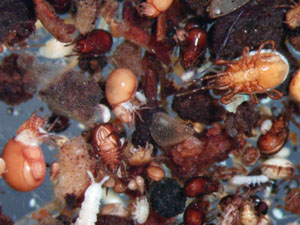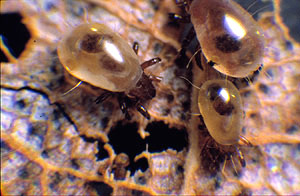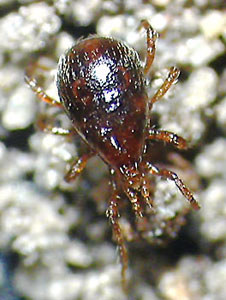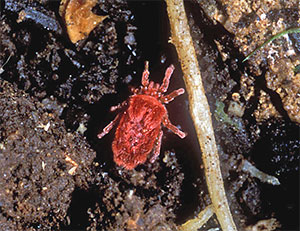| Acari

Soil mites
Common name: mites
Scientific name: phylum Arthropoda, class Arachnida.
Description
The terms "mites", Acari, or Acarina, are applied to several orders of small (even microscopic) arachnids, which are very diverse morphologically. Mites are the most numerous arthropods living in the soil. In the leaf litter and soil of a forest the population density of mites can reach hundreds of thousands of individuals per square meter. There are many thousands of described species, yet the fauna of much of the tropical soils is still unknown.
The body of a mite is divided into two regions - the anterior gnathosoma, which bears mouthparts and palps, and the large rounded idiosoma, which makes up the bulk of the body and bears four pairs of legs. The free-living mites of soil and litter usually have well-developed walking legs. The appearance of these mites is extremely varied. Some of the larger soil mites can exceed 5 mm in size, while small ones can be less than 0.2 mm. The mouthparts of mites are small appendages called chelicerae, which end in pincers. Chelicerae are variously modified in different mite groups according to their varied feeding modes, which include grazing on fungi and bacteria, piercing plant cells and animal skin, or preying on other invertebrates. Some of the most common soil mites are described below.
The members of the suborder Oribatida (=Cryptostigmata) are called "beetle" or "moss" mites. Adult oribatid mites usually have a strong exoskeleton, hardened by sclerotization, as in other mites, and by mineralization, similar to millipedes and isopodes. These slow moving mites are 0.2 - 1.0 mm in length and occur in the top layer of soil, in litter debris, and sometimes also on plants, mosses and lichens.

Immature oribatid mites feeding on a dead leaf.© Reproduced by kind permission of Roy Norton.
In contrast to many other microarthropods (=small athropods), oribatid mites reproduce slowly. In cold climates, their life cycle can stretch up to seven years (usually one-two years). Females lay few eggs. Many species are obligately parthenogenetic, with no males recorded. With their slow metabolic rate, slow development and low fecundity, Oribatida are not capable of fast population growth and are usually restricted to relatively stable environments. Oribatid mites graze on fungi and algae, consume decomposing plant matter and occasionally dead collembolans. Some oribatids feed on live nematodes. For many groups feeding habits are still unknown. Adult oribatid mites experience relatively little predation due to their strong exoskeleton, though they are subject to predation by ants, certain beetles and small salamanders. The soft-bodied nymphs are attacked by many soil predators. Oribatida comprise an important component of soil decomposers; their abundance, species composition and diversity in a particular habitat serve as good indicators of soil "health".

The large gamasid mite Pergamasus crassipes is a voracious predator. This litter-dwelling mite attacks most soft microarthropods of smaller size.
The cohort Gamasina (suborder Mesostigmata) contains fewer species than oribatid mites. Gamasid mites are universally present in soil, though not as numerous as oribatid mites. Almost all Gamasina are predators. Similar to spiders, they inject digestive liquid into the prey they have caught, and then suck up dissolved tissues. The abundance and community structure of these mites reflect the availability of their prey. The larger surface-dwelling gamasid mites attack small arthropods (collembolans, soft-bodied mites, insect larvae and eggs). Smaller deep-litter and soil forms are predominantly nematophagous and are the most important predators of nematodes in many habitats. Some species are fungal feeders. Several genera are considered good bioindicators of habitat and soil condition.
The mites of the suborder Prostigmata are extremely diverse in their size, appearance, and ecology.
This very large suborder includes 136 families, of which only 35 famillies are free-living inhabitants of soil and litter, while many others are plant feeders or parasites of animals. Some better known non-soil Prostigmata incude economically important plant pests, such as spider mites (family Tetranychidae), the gall mites
(superfamily Eriophyoidea), and the parasites of vertebrates - chiggers (family Trombiculidae), which can attack people.
The free-living soil Prostigmata include such diverse groups as tiny fungivorous Endeostigmata and Pygmephoroidae, active predators Bdelloidea, plant-feeding Cheyletidae, etc... Even within the same family there can be a variety of feeding modes, such as those found among the species of Tarsonemidae and Tydeidae.
 Red velvet mite, native beech forest, New Zealand
Most of the soil Prostigmata are microscopic, but one group - the velvet mites (family Trombidiidae) - are large and conspicuous. These large red mites can often be found slowly walking across the forest floor. They are bright red, puffy and velvety in appearance, and spectacularly large. These mites are harmless and very beautiful if examined under a magnifying glass.
The larvae of the velvet mites are external parasites of insects, and the adults are predatory on insect eggs, larvae, pupae, and on other small arthropods.
Included images:
- Order Trombidiformes
- Unidentified species - Kaikawa Scenic Reserve, North Island
- Unidentified species - Karewarewa Scenic Reserve, RI, North Island
- Unidentified species - Karewarewa Scenic Reserve, RI, North Island
- Unidentified species - Ohinetonga Scenic Reserve, TO, North Island (2 images)
- Unidentified species - Kawhatau Base, RI, North Island (4 images)
- Order Mesostigmata
- Pergamasus crassipes
- Other
- Unidentified species - Peel Forest Park, Dennistoun Bush, SC, South Island
- Unidentified species - Kawhatau Base, RI, North Island (2 images)
- Unidentified species - Kawhatau Base, RI, North Island
- Unidentified species - Whanganui National Park, WI, North Island
- Unidentified species - Whanganui National Park, WI, North Island
-
Further information on New Zealand Acari:
Collyer, E. 1982. The Phytoseiidae of New Zealand (Acarina) 1. The Genera Typhlodromus and Amblyseius - Keys and New Species. New Zealand Journal of Zoology 9(2), p. 185-206.
Emberson, R.M. 1973. Additions to the Macrochelid mites in N.Z. (Acarina: Mesostigmata: Macrochelidae). New Zealand Entomologist 5, p. 294-302.
Emberson, R.M. 1973. Macrochelid Mites in N.Z. (Acarina: Mesostigmata: Macrochelidae). New Zealand Entomologist 5, p. 118-127.
Emberson, R.M. 1980. Macrochelidae from the Kermadec Islands and a key to species of Macrocheles Latreille from the New Zealand region (Acari: Mesostigmata). New Zealand Entomologist 7, p. 135-138.
Fain, A., and T.D. Galloway. 1993. Mites (Acari) from nests of sea birds in New Zealand. Ii. Mesostigmata and Astigmata. Bulletin De L'Institut Royal Des Sciences Naturelles De Belgique, Entomologie 63, p. 95-111.
Lee, D.C., and P.E. Hunter. 1974. Arthropoda of the Subantarctic Islands of New Zealand. 6. Rhodacaridae (Acari: Mesostigmata). New Zealand Journal of Zoology, 1, p. 295-328.
Luxton, M. 1985. Cryptostigmata (Arachnida: Acari) - a concise review. Fauna of New Zealand 7, 106 pp.
Luxton, M. 1982a. Some New Species of Mites From New Zealand Peat Soils. New Zealand Journal of Zoology 9(3).
Luxton, M. 1982b. Studies on the Invertebrate Fauna of New Zealand Peat Soils. I. General Survey of the Sites. Revue D'Ecologie Et De Biologie Du Sol 19, p. 535-552.
Luxton, M. 1982c. Studies on the Invertebrate Fauna of New Zealand Peat Soils. Ii. Restiad Peats. Revue D'Ecologie Et De Biologie Du Sol 19, p. 553-578.
Luxton, M. 1982d. Studies on the Invertebrate Fauna of New Zealand Peat Soils Iv. Pasture Soils on Rukuhia Peat. Pedobiologia 24, p. 297-308.
Luxton, M. 1983a. Studies on the Invertebrate Fauna of New Zealand Peat Soils. III. - Fern Peats. Revue D'Ecologie Et De Biologie Du Sol 20, p. 87-109.
Luxton, M. 1883b. Studies on the Invertebrate Fauna of New Zealand. V. Pasture Soils on Kaipaki Peat. Pedobiologia 25, p. 135-148.
Ramsay G.W. 1959. Oribatid mites from The Brothers, Cook Strait, New Zealand. Unpublished PhD thesis. Wellington: Victoria University, 383 pp.
Stary, J., and W. Block. 1996. Oribatid mites (Acari: Oribatida) of the Falkland Islands, South Atlantic and their zoogeographical relationships. Journal of Natural History 30, p. 523-535.
Mite Resources on the Web
Acari: The Mites, The Tree of Life Web Project, includes information on mite biodiversity, ecology, and phylogeny.
Acari: Mites and Ticks: A Virtual Introduction, Systematic Entomology Laboratory, USDA. Well-illustrated site with information on diversity and ecology of mites, particularly plant-feeding mites and bee mites.
Australian Faunal Directory: ARACHNIDA: ACARINA, Department of Environment and
Heritage, checklist of Australian fauna, distribution, bibliography, and some information on ecology for mites and ticks.
Acarology WWW home page
PEET: Systematics, Ontogeny and Ecology of the Family Acaridae, by Barry OConnor.
This site describes a project by the University of Michigan to study and describe Acari of the infra-order Astigmata. The project looks at the taxonomy, systematics, organism development, life cycle and ecology of Astigmata mites. |